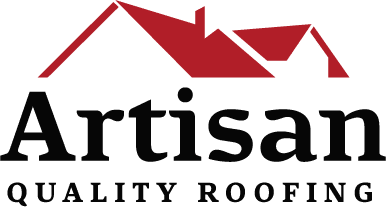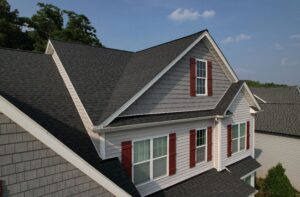

Most homeowners do not give a second thought to the type of roof style on their house. It’s not until they are house hunting for a new place or need a roof repair or replacement that most people start to consider how the roof style works to protect their home or home-to-be.
Most residential roof styles are sloped, designed to drain snow, sleet, and water off of the roof and into the gutter system as a way to protect your home, as well as protect the people and possessions inside it. Because of North Carolina’s variations in weather, two of the most common types of roofs in the area are hip roofs and gable roofs.
What is the difference between a hip roof vs gable roof? Which is the better roof style for your NC home? Check out our guide comparing hip roofs vs gable roofs, so you can get a better understanding of how each roofing materials and structure work to create the roof system that will best protect your home.
What is a Hip Roof?
When all four roof sides slope downward and the tops of each side meet at a square structure peak, this is a hip-style roof. Hip roofs are easy to detect by looking to see that all the roof sides slope down toward the walls of the house, with the walls sitting directly underneath the eaves of the roof on all sides. There are no vertical or flat surface ends on a hip roof as there are on some other roof styles.

Types of Hip Roofs
There are several different types of hip roofs:
- Pyramid roof: Also known as a “pavilion roof” when sitting atop a gazebo or other garden structure, the pyramid roof has all sides joined at a single peak like a pyramid.
- Hip and valley roof: Used on multi-surfaced roofs, hip and valley roofs have the traditional roof style of a hip roof where all four sides come together at a peak, but include “valleys” of split-level roofs, roof additions, or unique layouts to the roof and home.
- Half hip roof: Often installed as an add-on to a gable roof, the half hip roof, also called a “clipped gable roof” or “jerkin head roof” is when the end of the gable roof includes a small hip roof section that slopes downward toward the roof ridge.
- Mansard roof: A multi-surfaced roof style, the mansard roof, also called a “french roof” or “curb roof,” each side of the roof has two different sloped angles with the lower angle being steeper than the upper angle.
- Combination roof: Opposite to that of a mansard roof, a combination roof flares out at the bottom on all sides of the roof, with the lower level of the roof being at a much lower pitch.
What is a Gable Roof?
Gable roofs have two triangle-shaped slopes that extend from the bottom of the eaves of the roof to the peak of the roof ridge. Unlike a hip roof where there are four sides that form at the peak like a pyramid, the gable roof has two sides that meet in a triangular shape, with the other sides of the roof made of the home’s exterior materials such as stone, brick, or siding.
A “gable” is a triangle-shaped connecting point where two sloping sides come together.

Types of Gable Roofs
The varying styles of gable roofs are:
- Open gable roof: Two sloped sides of the roof meet at the top of the pitched roof, with open triangle-shaped sides and at least one gable.
- Front gable roof: Popular in colonial-style homes, a front gable roof is when there is the style of an open gable roof typically placed at the front of the house, over a porch with the front door to the house underneath it.
- Box gable roof: There are triangle-shaped slopes extending at each end of the roof and include a boxed-in roof section.
- Dutch gable roof: A roof style where a small gable is on top of a hip roof.
- Cross-gabled roof: Two or more intersecting roof pitches join together gables, forming L or T shapes.
Pros and Cons of Hip Roofs vs Gable Roofs
Both hip roofs and gable roofs have pros and cons to their roofing system components and the ways they affect the materials of the roof to protect your home.
Let’s explore the many pros and cons of hip vs gabled roofs.
Hip Roof Advantages
Hip roofs are often more stable than gable-style roofs and are preferred for high-wind areas and areas that get a lot of snowfall in the winter.
Some of the many advantages to hip roofs vs gable roofs are that hip roofs are:
- Easy to construct and build.
- Better for high-wind performance.
- Insured at lower costs in locations that experience high winds regularly.
- More stable than gable roofs.
- Aesthetically pleasing, thanks to the eaves surrounding the entire roof, adding curb appeal.
- Ideal for low-sloped roofs.
Gable Roof Advantages
A gable roof also called a “pitched roof” or “peaked roof” is the more affordable roofing option when compared to a hip roof. Additionally, they are the roof type that offers better ventilation and more attic space due to the roofing style and design features.
Some gable roof pros to consider when comparing gable and hip roofs are that a gable roof design consists of:
- Cost-efficiency.
- Better ventilation.
- A roof design that performs well for shedding ice, snow, and water.
- Gable vents that are effective for an attached garage.
- More attic space with vaulted ceilings.
- Great options to form combination roof designs for your home’s roof.
Hip Roof Disadvantages
Despite a hipped roof having many pros like the ability to stand up to high wind, there are some cons to hipped roofs, from affordability to less ventilation, it’s important to know how a simple hip roof performs when compared to a gable or crossed gable roof.
Disadvantages of a hip roof are:
- Worse snow performance when compared to gabled roofs.
- More susceptible to potential leaks or pooling of water.
- More expensive than a gable and a cross-gable roof.
- Less attic space due to the roof shape and steep slope of the roof.
Gable Roof Disadvantages
A gable roof consists of structural features that allow for space in the attic or vaulted ceilings. Whether a cross-gable roof, boxed gable roof, or another style of tented roof with a gable, there are some disadvantages to consider that could affect your choice when it comes to replacing your home’s roof.
Some disadvantages of gable roofs are:
- Worse wind performance when compared to a hip roof for high hurricane-prone areas.
- Due to poor wind performance, more roofing materials like shingles are more susceptible to damage.
- More difficult to build and install.
- Simple design features have less curb appeal than hip roof designs.
Is a Hip Roof vs Gable Roof Better for My Home?
The best way to consider what type of roof is better for your home: a hip roof vs a gable roof, there are a few factors to consider.
When choosing the type of structure for your new roof, consider:
- Your budget.
- The weather conditions of your location.
- The amount of living space you want.
- Your aesthetic preferences.
- The importance of energy efficiency.
The best way to decide between a hip roof vs gable roof is to speak to a residential roof repair professional to recommend what is the best roof type for your home.
Contact Artisan Quality Roofing for a Hip or Gable Replacement Roof
For over 10 years Artisan Quality Roofing has served Raleigh, NC area residents with the very best roofing services. From roof repairs, replacements, inspections, and maintenance, our residential roofing company offers the very best in quality service and professionalism.
If you need a new hip roof, gable roof, or another type of roof or service for your home, call us today at 919-906-3791 to request a free estimate.



